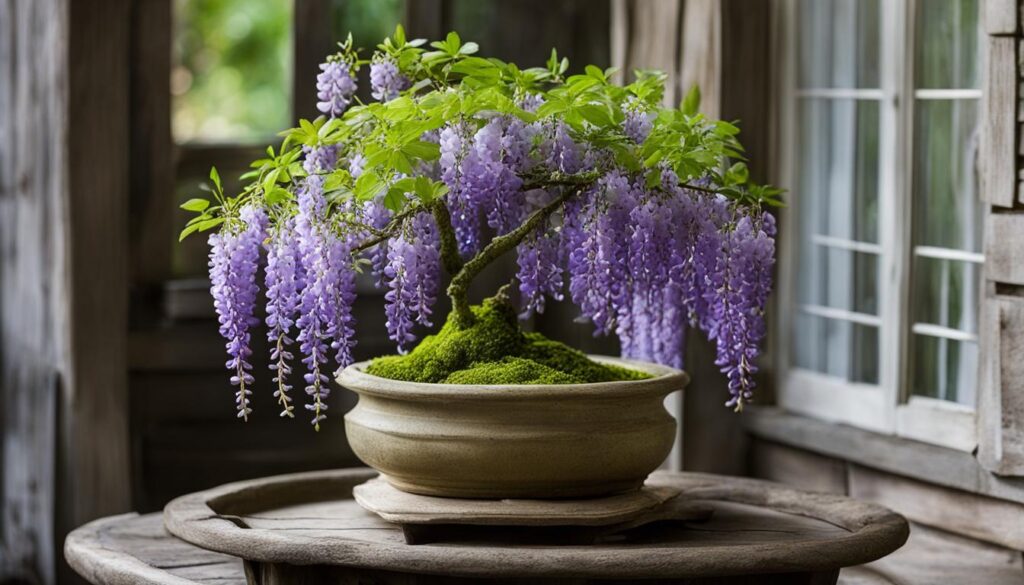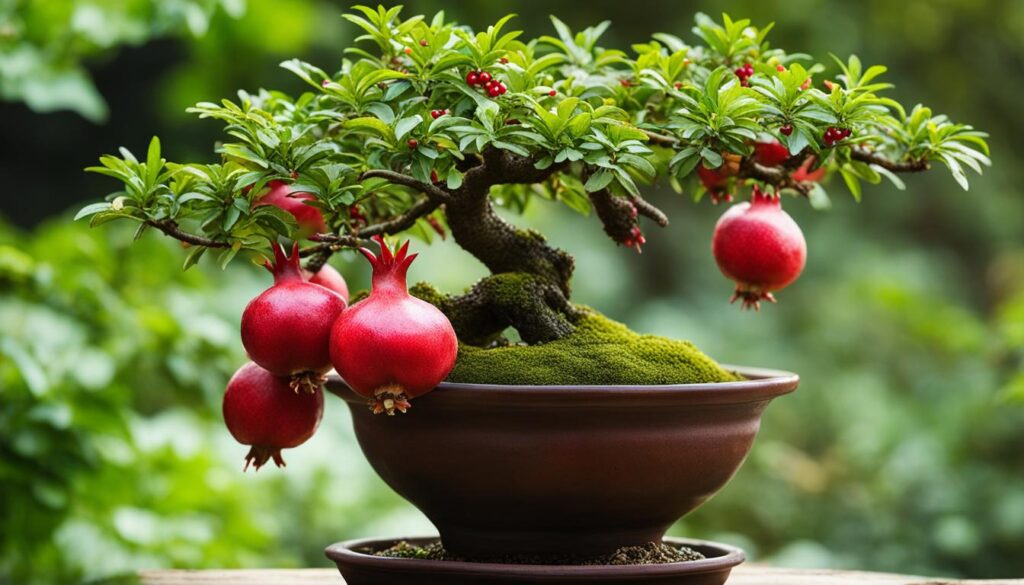Wisteria Bonsai is suitable for both beginners and seasoned enthusiasts. We will explore key aspects of care, including selecting the right species, optimal placement for sunlight and protection, proper watering techniques to maintain moisture levels , regular pruning to promote healthy growth, and methods for propagation. The Wisteria Bonsai, a miniature tree trained in bonsai style, is known for its delicate leaves and beautiful flower cascades. Are you ready to cultivate your own Wisteria Bonsai? Let’s begin!
Key Takeaways
ToggleDifferent species of Wisteria are used for making bonsai
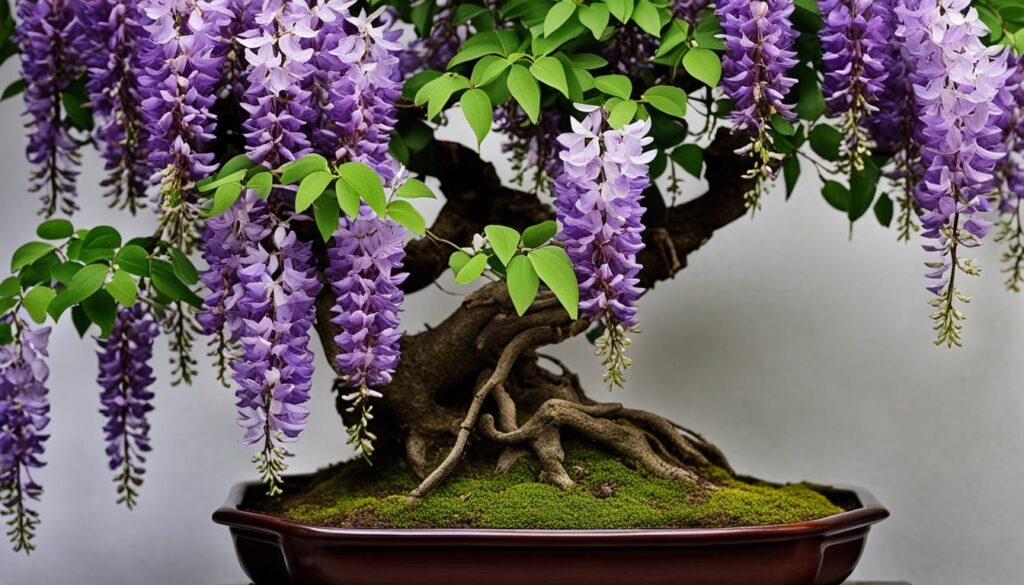
When creating bonsai trees, enthusiasts often choose from several Wisteria species, with Wisteria sinensis (Chinese Wisteria) and Wisteria floribunda (Japanese Wisteria) being the most common. Each species has distinct traits and care requirements, making them suitable for various bonsai styles.
Wisteria sinensis stands out for its vigorous growth and lavender or violet flower clusters, offering compact elegance.
Wisteria floribunda is known for its long, cascading flowers in shades of white, pink, and purple, making it ideal for cascading and informal upright styles.
Proper care, including understanding growth habits, pruning, and flowering, is key to cultivating a beautiful Wisteria bonsai. Both species allow you to highlight Wisteria’s natural beauty in miniature form.
More Bonsai Trees With Stunning Flowers >>>
Charm of Wisteria Bonsai
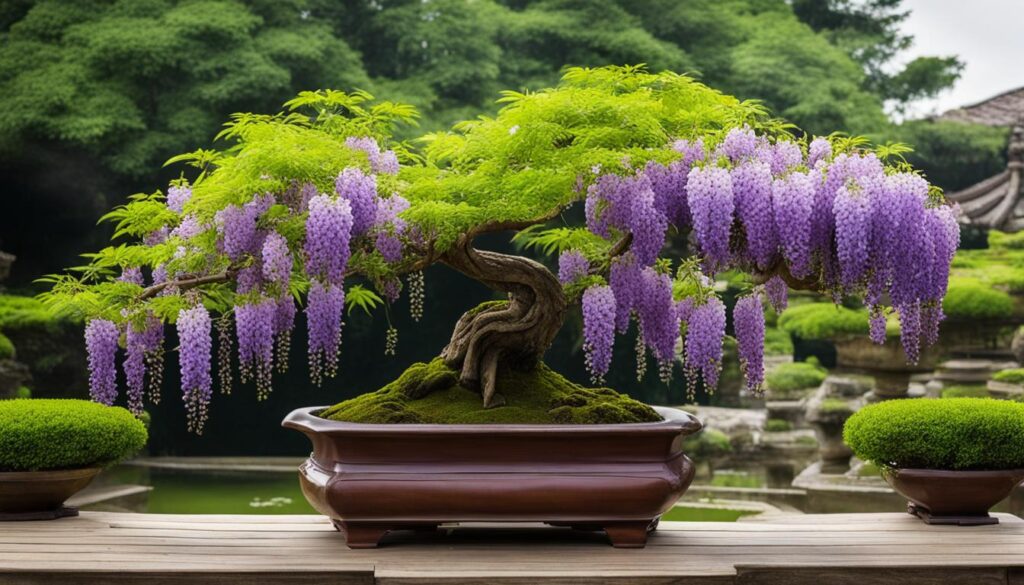
The Enchanting Aesthetic of Cascading Blossoms
One of the most striking features is its cascading clusters of blue, lavender, and white flowers. The flow of the blossoms creates a tranquil, eye-catching display. The petals hang delicately from the branches, captivating anyone who sees them.
Species Spotlight: Chinese vs. Japanese Wisteria
Two main species stand out in Wisteria Bonsai: Chinese Wisteria (Wisteria sinensis) and Japanese Wisteria (Wisteria floribunda). Both showcase cascading blooms but differ in their growth habits.
Chinese Wisteria grows vigorously and produces larger, fragrant flowers. It blooms earlier in the spring. Japanese Wisteria, with its smaller flowers and elegant foliage, blooms later, offering lavender-colored blossoms.
Size and Growth Expectations for Indoor and Outdoor Settings
Wisteria Bonsai varies in size depending on its environment. Indoors, it remains smaller with limited growth but still produces vibrant flowers. Outdoors, it can grow larger, with woody branches and cascading blossoms, thriving with enough space and sunlight.
| Species | Characteristics | Growth Habits | Ideal Settings |
|---|---|---|---|
| Chinese Wisteria | Larger-sized flowers, vigorous growth, strong fragrance | Early spring blooming | Outdoor gardens, spacious areas |
| Japanese Wisteria | Smaller, compact flowers, elegant foliage | Later spring blooming | Outdoor gardens, containers |
Optimal Placement for Thriving Wisteria Bonsai
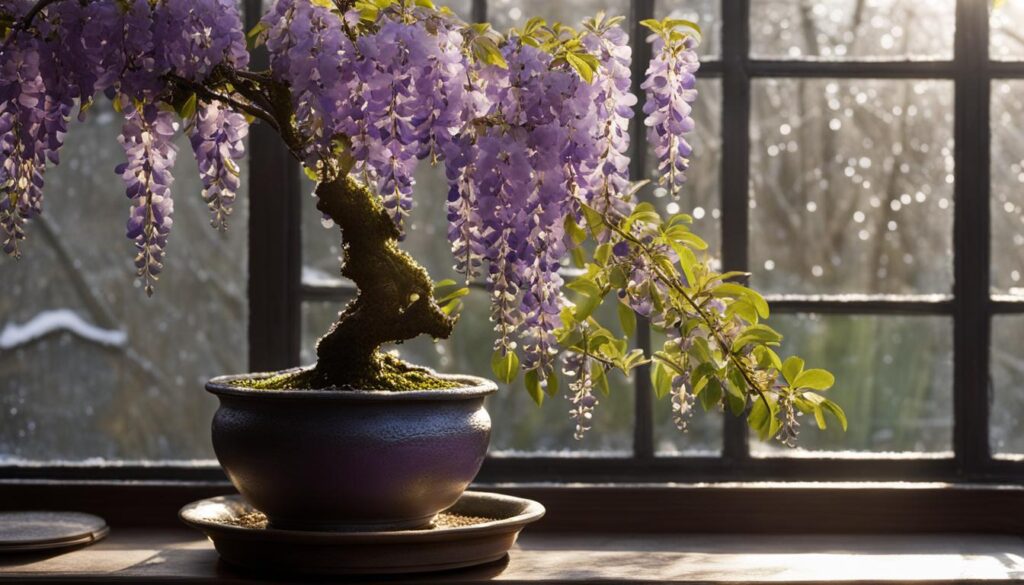
Proper placement is vital for your Wisteria Bonsai’s growth. Knowing its sunlight needs and adjusting with the seasons ensures a thriving tree.
Sunlight Needs and Seasonal Adjustments
Wisteria Bonsai requires at least 6 hours of direct sunlight daily. Position it by a sunny window or outdoors on a patio. Observe its exposure and shift placement as needed to maximize light.
Sunlight intensity varies by season. In summer, protect your bonsai from scorching sun by offering partial shade. In winter, increase sunlight to promote bud development and growth.
Protecting Your Bonsai in Winter
Winter care involves shielding your Wisteria Bonsai from frost and freezing temperatures. Placing it in a greenhouse or wrapping it in burlap can help. Maintain soil moisture without overwatering; avoid watering during freezing weather to prevent root damage.
The Essentials of Wisteria Bonsai Watering Techniques
Watering is a crucial aspect of Wisteria Bonsai care. Proper watering techniques ensure the health and vitality of the tree. Here, we will cover the essentials of watering your plant, including frequency, amount, and watering methods. We will also discuss the specific water requirements of it and provide tips on how to avoid overwatering or underwatering, which can lead to detrimental effects on the tree’s health.
If you want your Wisteria Bonsai to thrive, it’s essential to get the watering right. Adequate hydration is vital for its growth and overall well-being. Let’s dive into the techniques that will help you maintain a healthy watering routine for your plant.
Frequency:
Wisteria Bonsai trees require a regular watering schedule to ensure they receive the moisture they need. As a general guideline, check the soil moisture every few days. If the top inch of soil feels dry, it’s time to water your bonsai.
Amount:
When watering your Wisteria Bonsai, it’s important to strike the right balance. Avoid under-watering, as it can lead to dehydration and weaken the tree. Conversely, overwatering can cause root rot and other issues. Aim for thorough watering, ensuring the water reaches the roots and saturates the soil without causing it to become waterlogged.
Watering Methods:
There are a few different methods you can use to water your Wisteria Bonsai effectively. The most common techniques include:
- Top watering: Gently pour water onto the soil surface until it begins to drain out of the drainage holes. This ensures the entire root system is adequately hydrated.
- Submersion: You can also place your Wisteria Bonsai in a basin of water for a few minutes, allowing the roots to absorb the moisture. Make sure not to leave it submerged for too long.
- Drip irrigation: This method involves using a slow-drip system or a watering can with a fine nozzle to provide a controlled and even flow of water.
Remember, the specific water requirements may vary depending on factors such as climate, humidity levels, and the size of your bonsai tree. Regularly monitor the soil moisture and adjust your watering routine accordingly to meet the needs of your Wisteria Bonsai.
Feeding Your Wisteria Bonsai: Fertilization Fundamentals
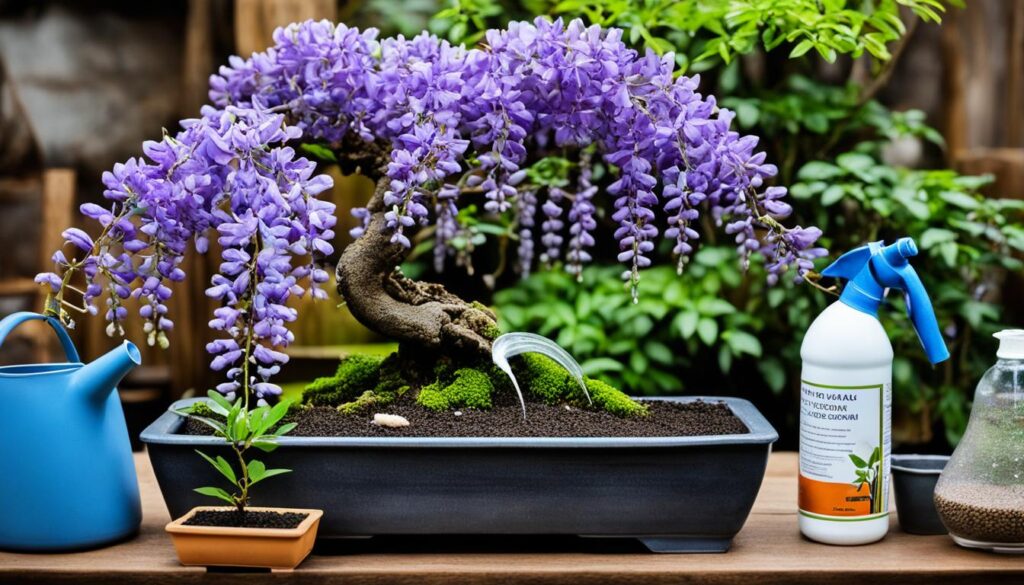
Fertilization is an essential aspect of caring for your Wisteria Bonsai. Providing the correct nutrients at the appropriate times is crucial for promoting overall health and vibrant flowering. In this section, we will delve into the fundamentals of fertilizing your Wisteria Bonsai, including the types of fertilizers to use, application methods, and the frequency of fertilization. We will also highlight the specific nutritional needs of Wisteria Bonsai and offer tips to help you achieve optimal growth and stunning blooms.
Types of Fertilizers: There are various fertilizers available for Wisteria Bonsai, including organic and synthetic options. Organic fertilizers, such as compost, well-rotted manure, and fish emulsion, provide slow-release nutrients and improve soil structure. Synthetic fertilizers, on the other hand, offer immediate nutrients in a more concentrated form. It’s essential to choose a fertilizer with balanced ratios of nitrogen (N), phosphorus (P), and potassium (K) for optimal Wisteria Bonsai growth.
Application Methods: When applying fertilizer to your Wisteria Bonsai, be sure to follow the package instructions for the specific product you are using. Generally, it is recommended to apply granular or pelletized fertilizers by sprinkling them evenly on the soil surface. Liquid fertilizers can be mixed with water and used for regular watering. Take care not to over-fertilize, as it can lead to nutrient imbalances and harm the tree.
Frequency of Fertilization: The frequency of fertilizer application depends on the type of fertilizer used and the growth stage of your Wisteria Bonsai. During the growing season, from spring to fall, it is typically recommended to fertilize every 4-6 weeks. However, make sure to adjust the frequency based on the specific requirements of your bonsai tree and monitor its response to the fertilizer.
Nutritional Needs: Wisteria Bonsai has specific nutritional needs that should be met for optimal growth and flowering. It requires a balanced supply of macronutrients, such as nitrogen, phosphorus, and potassium, as well as micronutrients, including calcium, magnesium, and iron. A deficiency or excess of any of these nutrients can impact the health and aesthetics of your Wisteria Bonsai. Regularly monitoring the foliage and conducting soil tests can help identify nutrient deficiencies or imbalances.
Tips for Optimal Growth and Vibrant Blooms:
- Apply fertilizer during the active growing season to support vigorous growth and stimulate flower formation.
- Follow the recommended dosage and application instructions provided by the fertilizer manufacturer.
- Monitor the health of your Wisteria Bonsai and adjust the fertilizer regimen accordingly.
- Avoid fertilizing in extreme weather conditions, such as during periods of drought or excessive heat, as it can stress the tree.
- Consider using slow-release fertilizers for prolonged nutrient availability and reduced risk of over-fertilization.
By understanding the fundamentals of fertilizing your Wisteria Bonsai and providing proper nutrition, you can ensure the health and vitality of your bonsai tree while enjoying its stunning blooms.
Pruning and Shaping Your Wisteria Bonsai
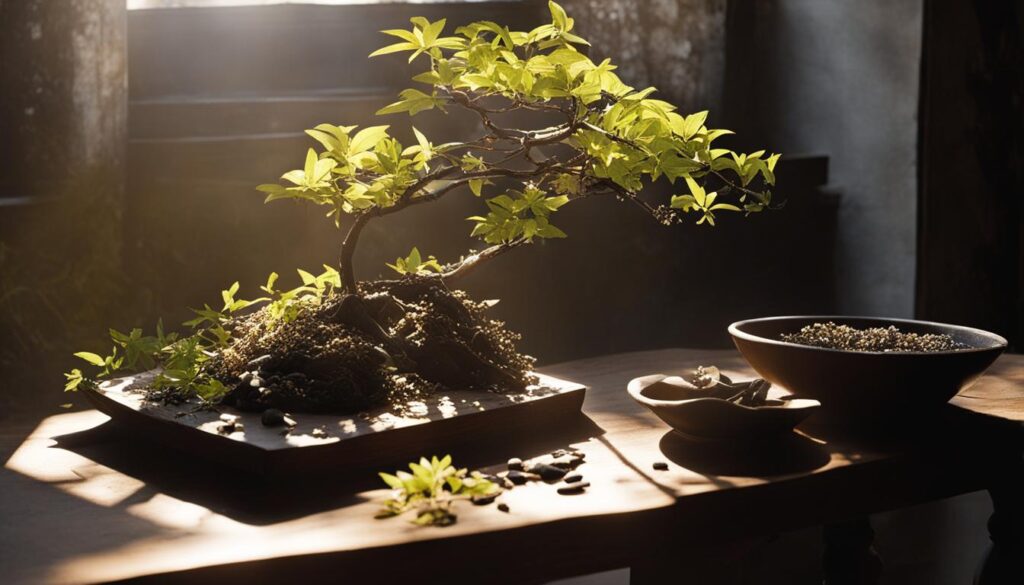
Pruning and shaping play a crucial role in maintaining the desired form and structure of your Wisteria Bonsai. By employing the right techniques and principles, you can create a masterpiece that reflects your artistic vision.
Timing is vital when it comes to pruning your Wisteria Bonsai. It is best to prune during the dormant season, typically in late winter or early spring. This promotes new growth and helps maintain the tree’s overall health.
When pruning, it is essential to use the proper tools, including bonsai shears or scissors. These specialized tools allow for precise cuts without damaging the tree. Be sure to clean and disinfect your tools before pruning to avoid the spread of diseases.
The steps involved in pruning your Wisteria Bonsai depend on your desired shape and style. Whether you want a formal upright, cascade, or semi-cascade form, you will need to carefully select which branches to remove and which to retain. Pruning techniques such as cutting back, thinning, and branch selection will help you achieve the desired aesthetic.
To encourage back-budding, which leads to the development of new branches, it is important to prune your Wisteria Bonsai correctly. Back-budding creates a dense foliage mass and enhances the overall visual appeal of your bonsai tree. By strategically pruning branches, you can stimulate the growth of new buds in desired areas.
Another aspect of pruning is ramification, which refers to the branching structure of your Wisteria Bonsai. Achieving balanced and well-distributed branches is essential for creating a harmonious bonsai tree. Regular pruning promotes ramification and helps maintain the aesthetic balance of your Wisteria Bonsai.
Key takeaways:
- Prune your Wisteria Bonsai during the dormant season for optimal results.
- Use bonsai shears or scissors to make precise cuts and maintain tool hygiene.
- Choose the right pruning techniques based on your desired shape and style.
- Encourage back-budding to promote the growth of new branches.
- Promote ramifications for a balanced, visually appealing bonsai tree.
When and How to Repot Your Wisteria Bonsai
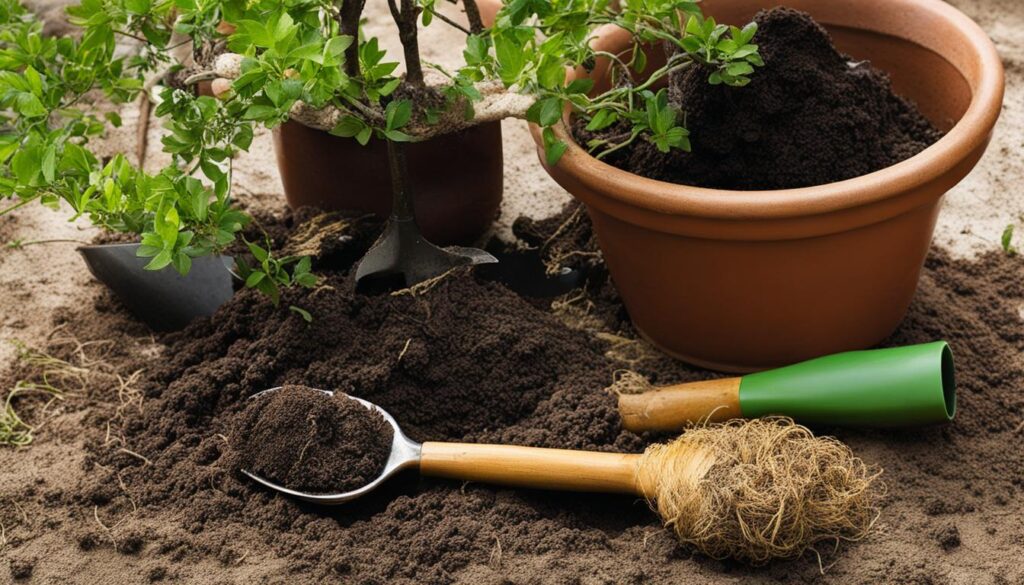
Repotting is an essential aspect of Wisteria Bonsai care. It rejuvenates the tree, promotes healthy root growth, and prevents root-bound conditions. Knowing the right time and technique for repotting is crucial for the long-term health and vitality of your Wisteria Bonsai.
Signs that indicate repotting is necessary:
- Roots growing densely and circling the pot
- Poor drainage despite proper watering
- Stunted growth or lack of vigor
- Soil breaking down and becoming compacted
When it comes to the timing of repotting, the best time is in early spring before the active growth period begins. This allows the tree to recover quickly and establish new roots before the growing season.
The steps involved in the repotting process:
- Carefully remove the tree from the pot, gently loosening the root ball.
- Inspect the roots for any signs of damage or disease. Trim away any dead or unhealthy roots.
- Prepare a new pot with proper drainage holes and fill it with a well-draining, bonsai-specific soil mix.
- Position the tree in the new pot, ensuring that the roots are spread out evenly and not bent or crowded.
- Backfill the pot with the soil mix, gently firming it around the roots to eliminate air pockets.
- Water the tree thoroughly, allowing the water to soak through the soil and drain away.
It is important to choose the right soil mix and pot size for your Wisteria Bonsai. A well-draining soil mix with good water retention properties, such as a blend of Akadama, lava rock, and pumice, is ideal for promoting healthy root development. Select a pot that is slightly larger than the current pot, allowing room for root growth while maintaining a balanced proportion with the tree.
Remember, repotting is a crucial part of Wisteria Bonsai care and should be performed every couple of years to ensure the ongoing health and vigor of your tree.
Propagation Techniques for Wisteria Bonsai Enthusiasts
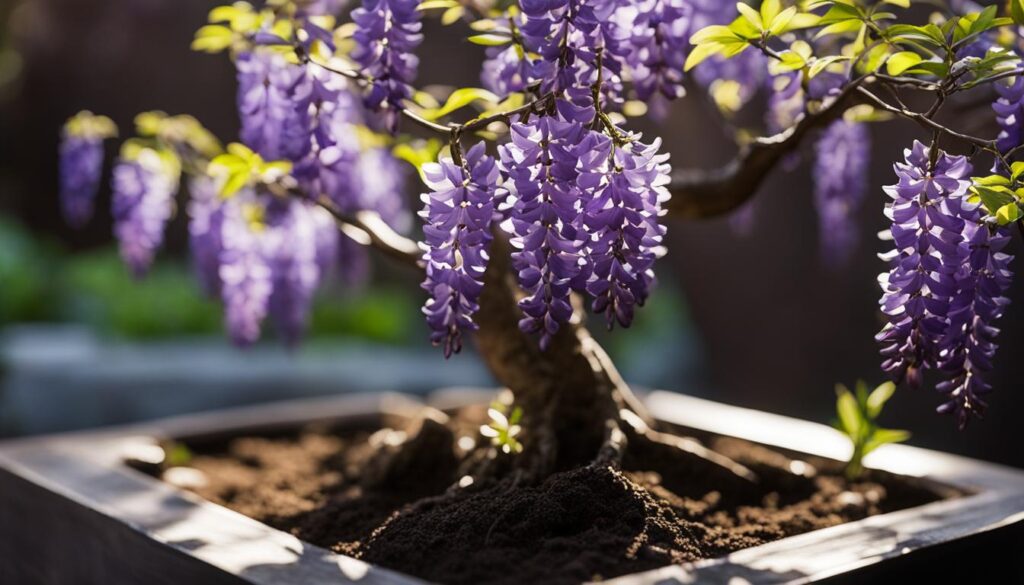
As a bonsai enthusiast, you have the opportunity to expand your Wisteria Bonsai collection and create new trees through propagation techniques. Propagation allows you to cultivate new Wisteria Bonsai trees, preserving the unique beauty of this species. In this section, we will explore various propagation methods, each with its own benefits and challenges.
Seed Propagation: Growing Wisteria Bonsai from seeds is a rewarding but time-consuming process. Collect seeds from ripe pods and provide the optimal conditions for germination. However, keep in mind that growing Wisteria Bonsai from seeds may result in variations from the parent tree in terms of characteristics and growth patterns.
Cuttings: Taking cuttings is a popular and reliable method for propagating Wisteria Bonsai. Select healthy, young shoots and make clean cuts. Then, place the cuttings in a suitable growing medium, ensuring they receive the right amount of moisture and light. With proper care and nurturing, these cuttings will develop into new Wisteria Bonsai trees.
Air Layering: Air layering is a technique used to propagate mature branches of Wisteria Bonsai. Choose a healthy, vigorous branch and remove a ring of bark to encourage the growth of new roots. Apply rooting hormone to enhance root development, wrap the wounded area with moist sphagnum moss, and protect it with plastic wrap. Once the new roots have formed, you can separate the branch and pot it as a new Wisteria Bonsai tree.
Grafting: Grafting is an advanced propagation technique where a cutting from one Wisteria Bonsai tree (called the scion) is joined with a rootstock from another compatible tree. This technique allows you to combine desirable characteristics from different specimens, producing unique and customized Wisteria Bonsai trees.
To successfully propagate Wisteria Bonsai using these techniques, it is essential to understand the specific requirements, timing, and challenges associated with each method. Experimentation and patience will be key as you explore different propagation techniques to create beautiful and unique Wisteria Bonsai trees.
Defending Against Pests and Diseases in Wisteria Bonsai
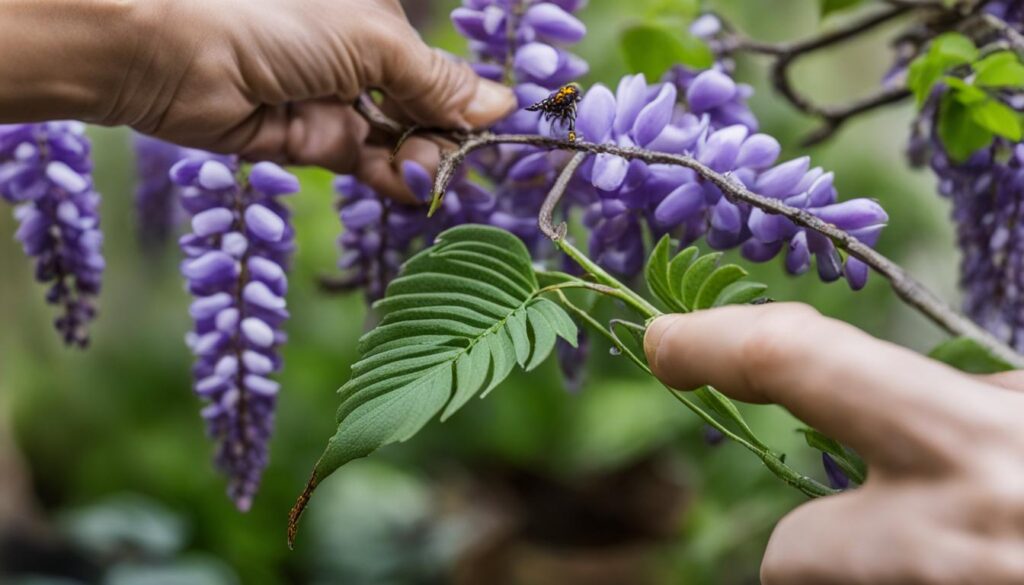
Like any other plant, Wisteria Bonsai can be susceptible to pests and diseases. To ensure the health and vitality of your bonsai tree, it is important to be aware of common pests and diseases that can affect Wisteria Bonsai and know how to prevent, detect, and treat them.
Pest Infestations:
Common pests that can attack Wisteria Bonsai include aphids, spider mites, and scale insects. These pests feed on the sap of the tree, weakening its overall health and potentially causing damage. Early detection is key to preventing severe infestations.
Signs of Pest Infestation:
- Wilting or drooping leaves
- Discolored or yellowing foliage
- Presence of sticky residue (honeydew) on leaves
- Small webs or cotton-like masses on the branches
- Visible insects crawling on the tree
Early detection and prompt action are crucial for effective pest control. Regularly inspect your Wisteria Bonsai for signs of infestation and take immediate steps to address the issue.
Prevention and Control:
To prevent pest infestations:
- Regularly inspect your Wisteria Bonsai for signs of pests.
- Maintain proper hygiene by removing fallen leaves and debris from the tree’s surroundings.
- Ensure good air circulation by positioning the bonsai tree away from walls or other obstructing objects.
- Consider using natural predators or parasitic insects to control pest populations.
If a pest infestation occurs:
- Isolate the affected tree to prevent the pests from spreading to other plants.
- Remove visible pests manually or by using a gentle stream of water.
- Use organic pest control methods such as neem oil or insecticidal soap.
- If necessary, consult with a professional for targeted chemical treatments.
Disease Prevention:
Wisteria Bonsai can also be vulnerable to diseases such as root rot, fungal infections, and leaf spot. To minimize the risk of disease:
- Ensure proper drainage by using well-draining soil and a bonsai pot with sufficient holes.
- Avoid overwatering the tree, as excess moisture can lead to root rot.
- Prune the bonsai regularly to promote airflow and reduce the risk of fungal infections.
- Monitor the tree for any signs of disease, such as discolored spots, wilting, or abnormal growth.
Early intervention is crucial for managing diseases effectively.
Choosing the Perfect Bonsai Pot for Your Wisteria
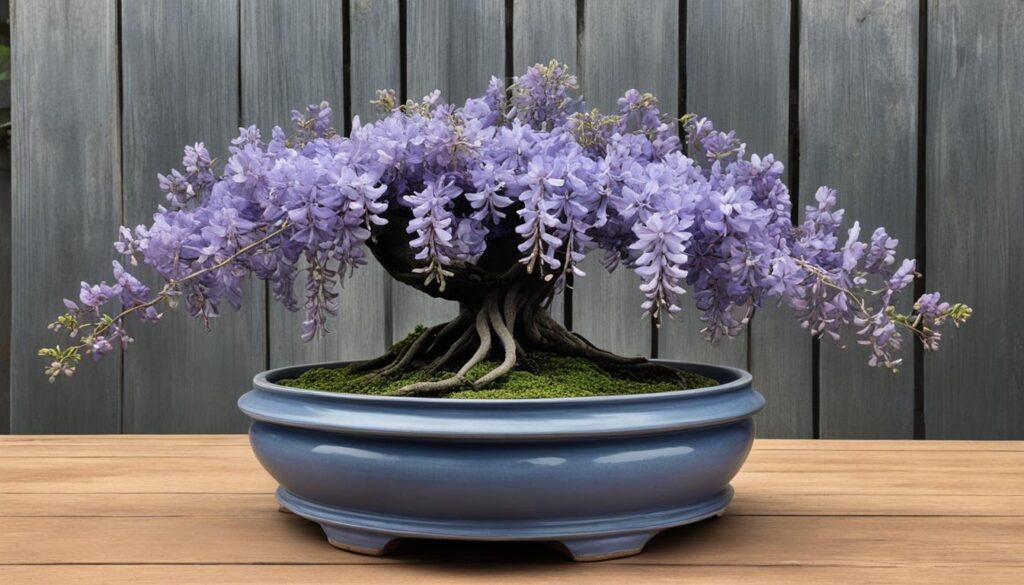
Choosing the right bonsai pot is essential for both the appearance and growth of your Wisteria Bonsai. Whether you’re new or experienced, consider factors like size, shape, material, and drainage.
For size, balance is key. A small pot restricts root growth, while a large one can slow development and diminish the tree’s look.
The pot’s shape should complement the tree’s style. Rectangular or oval pots suit formal or cascading styles, while round or square pots work for informal or semi-cascade forms.
Material impacts both health and aesthetics. Clay and ceramic pots offer moisture control and insulation, while plastic is lightweight and beginner-friendly.
Proper drainage is vital to avoid root rot. Choose pots with drainage holes and consider adding coarse gravel or bonsai soil for airflow.
When potting, techniques like root pruning ensure strong growth and prevent the tree from becoming root-bound.
Selecting the right pot and potting techniques will enhance your Wisteria Bonsai’s beauty, health, and lifespan. Let the pot complement your tree and reflect its natural charm.
| Factors to Consider for Bonsai Pot Selection | Potential Impact |
|---|---|
| Size | Affects root growth and proportion |
| Shape | Complements bonsai style and characteristics |
| Material | Affects aesthetics, insulation, and moisture regulation |
| Drainage | Prevents waterlogging and root rot |
Maintaining Humidity and Moisture for Wisteria Bonsai
To keep your Wisteria Bonsai healthy, maintain proper humidity and moisture levels. Humidity is vital for growth, and moisture control prevents root rot.
One way to create a suitable microclimate is with a humidity tray. Use a shallow tray filled with water under the bonsai pot, ensuring the water doesn’t touch the pot’s bottom. As the water evaporates, it increases humidity around the tree.
Misting the leaves regularly also helps maintain humidity, especially in dry or hot conditions.
For watering, find a balance to avoid overwatering or underwatering. Check soil moisture by inserting your finger about an inch deep—if dry, water the tree thoroughly, letting excess water drain.
Overwatering leads to root rot; underwatering causes the tree to dry out. Adjust your watering schedule based on your bonsai’s needs.
| Humidity Maintenance Tips | Moisture Control Techniques |
|---|---|
| Use a humidity tray to increase moisture levels around the bonsai | Check the moisture level of the soil before watering |
| Mist the leaves regularly to provide humidity | Water thoroughly, ensuring water reaches the roots |
| Monitor the humidity levels in the bonsai’s environment | Avoid waterlogged conditions to prevent root rot |
| Adjust watering frequency based on the tree’s moisture needs | Find a balance between adequate moisture and avoiding dryness |
Wisteria Bonsai: An Investment in Patience and Beauty
Growing and nurturing a Wisteria Bonsai is more than just a hobby; it’s an investment in patience and beauty. As a bonsai enthusiast, you understand the dedication required to transform a tiny sapling into a magnificent work of living art.
Creating a thriving Wisteria Bonsai tree takes time and commitment. It is a journey that requires your unwavering attention and care as you provide the necessary nutrients, shape the branches, and protect them from pests and diseases. While the process can sometimes test your patience, the ultimate rewards are truly worth every moment of anticipation.
Long-Term Commitment to Growth
Investing in a Wisteria Bonsai means embarking on a long-term commitment to its growth. Each year, as you tend to its needs and witness its progress, you’ll develop a deep connection with your bonsai. The relationship you form with your Wisteria Bonsai is not just about nurturing a plant; it’s about personal growth and the joy of witnessing the ever-evolving beauty that you help cultivate.
First Blossoms
The emergence of the first blossoms is an incredible milestone in the life of your Wisteria Bonsai. As you patiently wait for those delicate flowers to unfurl, you’ll experience a sense of awe and accomplishment. The vibrant hues and mesmerizing fragrance of the Wisteria blossoms will fill your soul with a deep sense of satisfaction, knowing that your dedication and efforts have borne fruit.
So, as you embark on your journey with Wisteria Bonsai, remember that it is not merely a tree but a living testament to your patience and love for nature. The investment you make in this captivating bonsai will reward you with a lifetime of beauty and fulfillment.
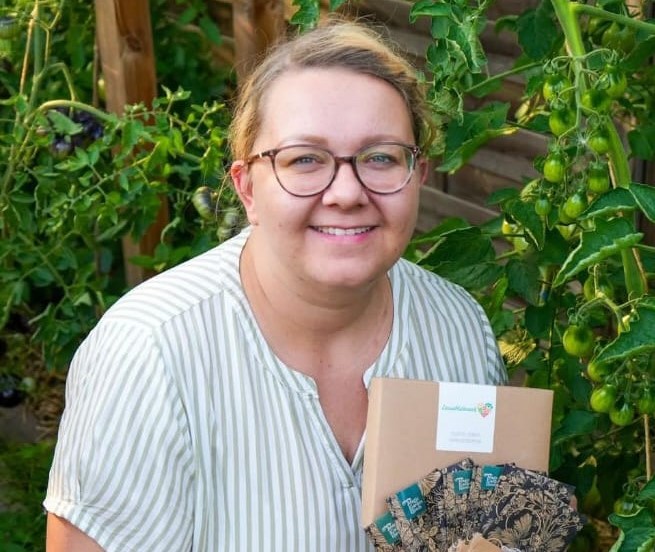
Karen Phillips, Bonsai expert and blogger. Read more about me here

